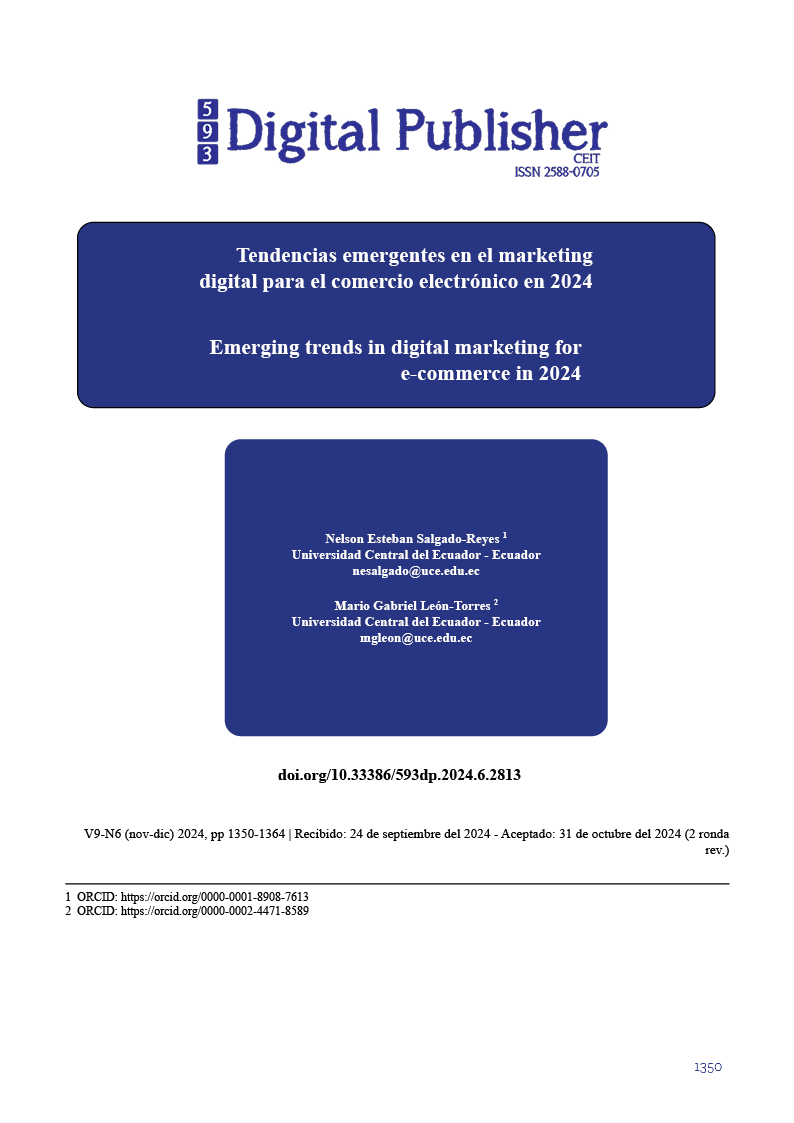Emerging trends in digital marketing for e-commerce in 2024
Main Article Content
Abstract
Este artículo examina las tendencias emergentes en marketing digital y su impacto en el comercio electrónico para el año 2024. A través de un enfoque mixto que combina análisis cuantitativo y cualitativo, se investigaron tecnologías como la realidad aumentada (AR), la realidad virtual (VR), el blockchain, la inteligencia artificial (IA), la búsqueda por voz y la personalización avanzada. El análisis cuantitativo se basó en datos de 50 empresas de comercio electrónico, mientras que el análisis cualitativo se realizó mediante entrevistas en profundidad con directores de marketing y tecnología de 10 empresas seleccionadas.
Los resultados indican que la implementación de AR y VR mejora significativamente la experiencia del cliente y las tasas de conversión, aunque enfrenta desafíos técnicos y de usabilidad. La tecnología blockchain aumenta la transparencia y seguridad de las transacciones, reduciendo el fraude, pero presenta barreras en términos de complejidad técnica y costos. La IA permite una personalización avanzada, mejorando la relevancia del contenido y las ventas, aunque genera preocupaciones sobre la privacidad de los datos. La optimización para búsqueda por voz mejora la eficiencia del servicio al cliente, facilitando interacciones más rápidas y naturales, aunque la integración con sistemas existentes puede ser compleja. Finalmente, la personalización avanzada es crucial para la fidelización del cliente, proporcionando experiencias de compra personalizadas y satisfactorias, aunque requiere una infraestructura tecnológica robusta.
Downloads
Article Details

This work is licensed under a Creative Commons Attribution-NonCommercial-ShareAlike 4.0 International License.
1. Derechos de autor
Las obras que se publican en 593 Digital Publisher CEIT están sujetas a los siguientes términos:
1.1. 593 Digital Publisher CEIT, conserva los derechos patrimoniales (copyright) de las obras publicadas, favorece y permite la reutilización de las mismas bajo la licencia Licencia Creative Commons 4.0 de Reconocimiento-NoComercial-CompartirIgual 4.0, por lo cual se pueden copiar, usar, difundir, transmitir y exponer públicamente, siempre que:
1.1.a. Se cite la autoría y fuente original de su publicación (revista, editorial, URL).
1.1.b. No se usen para fines comerciales u onerosos.
1.1.c. Se mencione la existencia y especificaciones de esta licencia de uso.
References
Anantharaman, R., Badhusha M H N, M., Thomas, S., y Soundarraj, P. L. (2024). Analyzing The Role of Digital Marketing in Growth of E-Commerce in India: A Multiple Holistic Approach. Journal of Informatics Education and Research, 4(2), 749-755. https://doi.org/https://doi.org/10.52783/jier.v4i2.835
Casino, F., y Dasaklis, T. K. (2019). A systematic literature review of blockchain-based applications: Current status, classification and open issues. Telematics and Informatics, 36, 55-81.
Chaffey, D. E.-C. (2019). Digital marketing: Strategy, implementation and practice. Pearson UK.
Davenport, T. H., Guha, A., y Grewal, D. B. (2020). How artificial intelligence will change the future of marketing. Journal of the Academy of Marketing Science, 48(1), 24-42.
Huang, M. H., y Rust, R. T. (2020). Engaged to a robot? The role of AI in service. Journal of Service Research, 24(1), 30-41.
Ma, X., y Ma, X. (2024). New marketing strategy model of E-commerce enterprises in the era of digital economy. Helyon, 10, 1-12. https://doi.org/https://doi.org/10.1016/j.heliyon.2024.e29038
McLean, G., y Wilson, A. (2019). Shopping in the digital world: Examining customer engagement through augmented reality mobile applications. Computers in Human Behavior, 101, 210-224.
Nodirovna, M. S., y Sharif oʻg‘li, A. S. (2024). E-Commerce Trends: Shaping The Future of Retail. Open Herald: Periodical of Methodical Research, 2(3), 46–49. https://academiaone.org/index.php/6/article/view/637
Poushneh, A. (2018). Augmented reality in retail: A trade-off between user’s control of access to personal information and augmentation quality. Journal of Retailing and Consumer Services, 41, 169-176.
Rao, S. G., Neha, P., y Sankar, T. (2020)). Emerging Trends in E-Commerce and their Impact on Businessf. International Journal of Advanced Science and Technology, 29(3), 13617 - 13624.
Sanbella, L., Versie, k. V., y Audiah, S. (2024). Online Marketing Strategy Optimization to Increase Sales and E-Commerce Development: An Integrated Approach in the Digital Age. Startupreneur Business Digital (SABDA), 3(1), 54-66. https://doi.org/https://doi.org/10.33050/sabda.v3i1.492
Semenda, O., Sokolova, Y., Korovina, O., Bratko, O., y Polishchuk, I. (2024). Using Social Media Analysis to Improve E-commerce Marketing Strategies. International Review of Management and Marketing,, 14(4), 61-71. https://doi.org/https://doi.org/10.32479/irmm.16196
Sugiharto, B. H. (2024). The Role of E-commerce for MSMEs as a Digital Marketing Strategy in Facing Industrial Revolution 4.0. Management Studies and Business Journal (PRODUCTIVITY), 1(1), 99-107. https://doi.org/https://doi.org/10.62207/80ndq458
Vyas, S. K., Vyas, L., Singh, S., y Joshi, M. (2023). Future of E-Commerce: A Robust Review. En A. Nagar, D. Singh Jat, D. Mishra, y A. Joshi, Intelligent Sustainable Systems. Lecture Notes in Networks and Systems (pp. 697–710). Springer. https://doi.org/https://doi.org/10.1007/978-981-19-7663-6_66
Wedel, M., y Kannan, P. K. (2016). Marketing analytics for data-rich environments. Journal of Marketing, 80(6), 97-121.
Flavián, C., Ibáñez-Sánchez, S., & Orús, C. (2019). The impact of virtual, augmented and mixed reality technologies on the customer experience. Journal of Business Research, 100, 547-560. https://doi.org/10.1016/j.jbusres.2018.10.050
Hoy, M. B. (2018). Alexa, Siri, Cortana, and more: An introduction to voice assistants. Medical Reference Services Quarterly, 37(1), 81-88. https://doi.org/10.1080/02763869.2018.1404391
Huang, M. H., & Rust, R. T. (2018). Artificial intelligence in service. Journal of Service Research, 21(2), 155-172. https://doi.org/10.1177/1094670517752459
Kim, A. J., & Ko, E. (2012). Do social media marketing activities enhance customer equity? An empirical study of luxury fashion brand. Journal of Business Research, 65(10), 1480-1486. https://doi.org/10.1016/j.jbusres.2011.10.014
Loureiro, S. M. C., Guerreiro, J., & Tussyadiah, I. (2020). Artificial intelligence in business: State of the art and future research agenda. Journal of Business Research, 129, 911-926. https://doi.org/10.1016/j.jbusres.2020.11.048
Montgomery, A. L., & Smith, M. D. (2009). Prospects for personalisation on the internet. Journal of Interactive Marketing, 23(2), 130-137. https://doi.org/10.1016/j.intmar.2009.02.001
Nakamoto, S. (2008). Bitcoin: A peer-to-peer electronic cash system. Retrieved from https://bitcoin.org/bitcoin.pdf
Purington, A., Taft, J. G., Sannon, S., Bazarova, N. N., & Taylor, S. H. (2017). “Alexa is my new BFF”: Social roles, user satisfaction, and personification of the Amazon Echo. In Proceedings of the 2017 CHI Conference Extended Abstracts on Human Factors in Computing Systems (pp. 2853-2859). https://doi.org/10.1145/3027063.3053246
Tam, K. Y., & Ho, S. Y. (2006). Understanding the impact of web personalization on user information processing and decision outcomes. MIS Quarterly, 30(4), 865-890. https://doi.org/10.2307/25148757
Wang, Y., Han, J. H., & Beynon-Davies, P. (2019). Understanding blockchain technology for future supply chains: A systematic literature review and research agenda. Supply Chain Management: An International Journal, 24(1), 62-84. https://doi.org/10.1108/SCM-03-2018-0148



